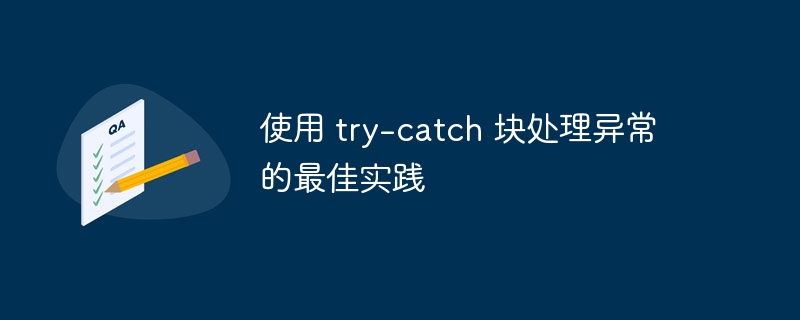使用 try-catch 块处理异常的最佳实践
来源:dev.to
时间:2024-09-25 18:19:12 128浏览 收藏
一分耕耘,一分收获!既然都打开这篇《使用 try-catch 块处理异常的最佳实践》,就坚持看下去,学下去吧!本文主要会给大家讲到等等知识点,如果大家对本文有好的建议或者看到有不足之处,非常欢迎大家积极提出!在后续文章我会继续更新文章相关的内容,希望对大家都有所帮助!

1。捕获特定异常
始终首先捕获最具体的异常。这有助于识别确切的问题并进行适当的处理。
try {
// code that may throw an exception
} catch (filenotfoundexception e) {
// handle filenotfoundexception
} catch (ioexception e) {
// handle other ioexceptions
}
2。避免空的 catch 块
空的 catch 块会隐藏错误并使调试变得困难。始终记录异常或采取一些操作。
try {
// code that may throw an exception
} catch (ioexception e) {
e.printstacktrace(); // log the exception
}
3。使用 final 块进行清理
finally 块用于执行重要的代码,例如关闭资源,无论是否抛出异常。
bufferedreader reader = null;
try {
reader = new bufferedreader(new filereader("file.txt"));
// read file
} catch (ioexception e) {
e.printstacktrace();
} finally {
if (reader != null) {
try {
reader.close();
} catch (ioexception e) {
e.printstacktrace();
}
}
}
4。不要抓住可抛出的
避免捕获 throwable,因为它包含不应该捕获的错误,例如 outofmemoryerror。
try {
// code that may throw an exception
} catch (exception e) {
e.printstacktrace(); // catch only exceptions
}
5。正确记录异常
使用 log4j 或 slf4j 等日志框架来记录异常,而不是使用 system.out.println。
private static final logger logger = loggerfactory.getlogger(myclass.class);
try {
// code that may throw an exception
} catch (ioexception e) {
logger.error("an error occurred", e);
}
6。必要时重新抛出异常
有时,最好在记录异常或执行某些操作后重新抛出异常。
try {
// code that may throw an exception
} catch (ioexception e) {
logger.error("an error occurred", e);
throw e; // rethrow the exception
}
7。使用 multi-catch 块
在 java 7 及更高版本中,您可以在单个 catch 块中捕获多个异常。
try {
// code that may throw an exception
} catch (ioexception | sqlexception e) {
e.printstacktrace(); // handle both ioexception and sqlexception
}
8。避免过度使用控制流异常
异常不应用于常规控制流。它们适用于特殊条件。
// Avoid this
try {
int value = Integer.parseInt("abc");
} catch (NumberFormatException e) {
// Handle exception
}
// Prefer this
if (isNumeric("abc")) {
int value = Integer.parseInt("abc");
}
文中关于的知识介绍,希望对你的学习有所帮助!若是受益匪浅,那就动动鼠标收藏这篇《使用 try-catch 块处理异常的最佳实践》文章吧,也可关注golang学习网公众号了解相关技术文章。
声明:本文转载于:dev.to 如有侵犯,请联系study_golang@163.com删除
相关阅读
更多>
-
501 收藏
-
501 收藏
-
501 收藏
-
501 收藏
-
501 收藏
最新阅读
更多>
-
403 收藏
-
397 收藏
-
357 收藏
-
158 收藏
-
486 收藏
-
459 收藏
-
296 收藏
-
491 收藏
-
208 收藏
-
356 收藏
-
437 收藏
-
427 收藏
课程推荐
更多>
-

- 前端进阶之JavaScript设计模式
- 设计模式是开发人员在软件开发过程中面临一般问题时的解决方案,代表了最佳的实践。本课程的主打内容包括JS常见设计模式以及具体应用场景,打造一站式知识长龙服务,适合有JS基础的同学学习。
- 立即学习 543次学习
-

- GO语言核心编程课程
- 本课程采用真实案例,全面具体可落地,从理论到实践,一步一步将GO核心编程技术、编程思想、底层实现融会贯通,使学习者贴近时代脉搏,做IT互联网时代的弄潮儿。
- 立即学习 516次学习
-

- 简单聊聊mysql8与网络通信
- 如有问题加微信:Le-studyg;在课程中,我们将首先介绍MySQL8的新特性,包括性能优化、安全增强、新数据类型等,帮助学生快速熟悉MySQL8的最新功能。接着,我们将深入解析MySQL的网络通信机制,包括协议、连接管理、数据传输等,让
- 立即学习 500次学习
-

- JavaScript正则表达式基础与实战
- 在任何一门编程语言中,正则表达式,都是一项重要的知识,它提供了高效的字符串匹配与捕获机制,可以极大的简化程序设计。
- 立即学习 487次学习
-

- 从零制作响应式网站—Grid布局
- 本系列教程将展示从零制作一个假想的网络科技公司官网,分为导航,轮播,关于我们,成功案例,服务流程,团队介绍,数据部分,公司动态,底部信息等内容区块。网站整体采用CSSGrid布局,支持响应式,有流畅过渡和展现动画。
- 立即学习 485次学习
